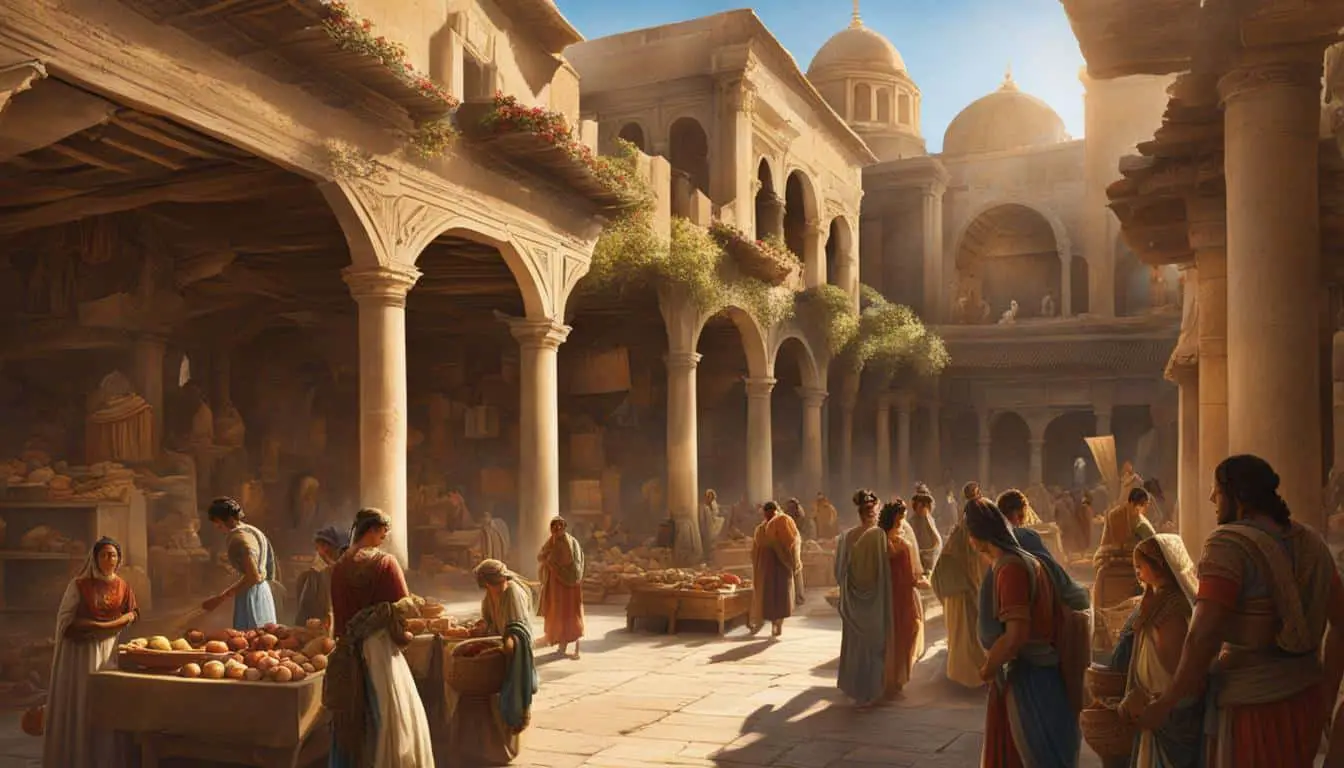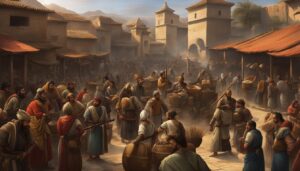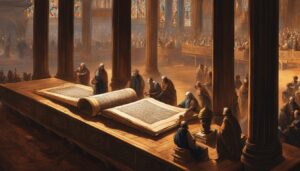
In Biblical times, art and architecture flourished, leaving behind a rich legacy of ancient structures and historical artifacts. These artistic expressions not only showcased the architectural designs of the era but also conveyed profound religious symbolism. Join me on a visual journey as we explore the captivating world of art and architecture in Biblical times.
Key Takeaways:
- Art and architecture in Biblical times showcased religious symbolism and conveyed profound meanings.
- Ancient structures and historical artifacts provide a glimpse into the artistic achievements of the era.
- The architectural designs of the time were influenced by religious beliefs and expressed through artistic expressions.
- Biblical art and architecture left a lasting impact on subsequent periods, influencing future artistic and cultural developments.
- Exploring the visual language and cultural influences of this era enhances our understanding of art and architecture in Biblical times.
The Influence of Byzantine and Insular Art on Romanesque Art
In the study of medieval art, the term “Romanesque” was coined to encompass the artistic production of Western Europe during the 11th and 12th centuries. Romanesque art drew influences from various sources, including Roman monuments, Insular art from Northern Europe, and Byzantine art through Italian connections. The artists of the Romanesque period incorporated elements such as acanthus-leaf motifs, coherent modeling of the human body, and a repertoire of gestures expressing emotions. However, they added their own creativity and drama to these influences, creating a unique visual language that conveyed the tenets of the Christian faith.
Romanesque art showcased its Christian subject matter through the use of biblical themes. Scenes from the Old and New Testaments were depicted on church doors, capitals, and walls. The typological approach, which compared events and characters from the Old Testament to prefigure the coming of Christ, was also commonly used. These visual representations not only served as decorative elements but also conveyed religious narratives and messages.
One of the influences on Romanesque art was Byzantine art, which had a significant impact through Italian connections. Byzantine art was known for its use of vibrant colors, intricate patterns, and gold leaf. These visual elements found their way into Romanesque art, enriching the visual language and adding a sense of grandeur. The influence of Insular art from Northern Europe also played a role in shaping Romanesque art. Insular art was characterized by its intricate interlaced patterns, vibrant colors, and the use of animal motifs. These elements were incorporated into Romanesque art, adding a touch of intricacy and complexity.
| Byzantine Art Influences on Romanesque Art | Insular Art Influences on Romanesque Art |
|---|---|
| Use of vibrant colors | Intricate interlaced patterns |
| Intricate patterns | Vibrant colors |
| Gold leaf decorations | Use of animal motifs |
Romanesque art, while rooted in various influences, developed its distinctive style that was Roman in essence but Christian in subject matter. The incorporation of Byzantine and Insular art elements added depth and richness to the visual language. The vibrant colors, intricate patterns, and use of gold leaf brought a sense of grandeur and spirituality to the artworks. Through biblical themes and typological interpretations, Romanesque art became a medium through which the stories and teachings of the Christian faith were visually communicated.
Early Christian Art and Architecture
Early Christian art flourished during the third century, reflecting the growing influence of Christianity and the interaction with the Greco-Roman world. One of the significant contributions of this period was the development of funerary art in the catacombs of Rome. The catacombs served as burial sites and places of worship for early Christians, providing a rich source of artistic expression.
Symbolic imagery played a crucial role in early Christian art. Motifs such as the fish and anchor epitaph were used to discreetly identify Christians and express their faith. These symbols represented their belief in Christ as the divine “Good Shepherd” and the hope of salvation. Wall paintings in the catacombs depicted biblical narratives and scenes, including the story of Jonah and the Whale, which symbolized Christ’s resurrection.
Early Christian architecture went through a transformation as well. During the pre-Constantinian period, Christian worship spaces were integrated into domestic architecture. However, with the rise of Christianity, more spacious and dedicated structures were built, known as Christian basilicas. Inspired by Roman civic architecture, these basilicas emphasized large interior spaces and featured apses as focal points for religious ceremonies and authority.
Early Christian art and architecture laid the foundation for the visual language of Christianity that would continue to evolve and develop throughout history. The symbolic imagery, typological interpretations, and architectural innovations of this period continue to influence artistic expressions of faith in the present day.
| Features of Early Christian Art and Architecture | |
|---|---|
| Funerary Art in Catacombs | Depiction of biblical narratives and symbolic motifs |
| Symbolic Imagery | Use of fish and anchor epitaphs to identify Christians |
| The Good Shepherd | Representation of Christ as the divine shepherd |
| Jonah and the Whale | Symbolic depiction of Christ’s resurrection |
| Christian Basilicas | Inspired by Roman civic architecture, emphasized large interior spaces |
Conclusion
The art and architecture of Biblical times underwent significant transformations, resulting in the creation of ancient Christian art that left a lasting impact. Artists and architects of this era used their creativity to express their faith and convey Christian symbolism through their work. The architectural transformation during this period led to the construction of monumental stone churches and Christian basilicas, reflecting the growth of Christianity and the need to accommodate larger congregations.
Ancient Christian art not only served as a means of artistic expression but also as a vehicle to communicate the stories and teachings of the Christian faith. The incorporation of biblical themes, typological interpretations, and rich symbolism created a distinct visual language that resonated with believers and conveyed the sacredness of religious spaces.
The art and architecture of Biblical times were not created in isolation but were influenced by various cultural traditions. Byzantine and Insular art played a significant role in shaping the artistic style of the Romanesque period. The fusion of these influences resulted in a unique blend of artistic expression that was both rooted in ancient traditions and infused with Christian themes.
Today, the surviving ancient structures and historical artifacts offer a glimpse into the rich artistic and cultural achievements of Biblical times. They provide us with a visual journey through the world of art and architecture, showcasing the talent and creativity of artists and the cultural influences that shaped their work.
FAQ
What is Romanesque art?
Romanesque art refers to the artistic production in Western Europe during the 11th and 12th centuries. It drew influences from various sources, including Roman monuments, Insular art, and Byzantine art.
What were the main features of Romanesque churches?
Romanesque churches were often built with a plan based on the Roman basilica, featuring a nave, lateral aisles, and an apse. They also had transepts, ambulatories, and radiating chapels. These churches accommodated larger numbers of priests, monks, and pilgrims.
What types of artworks were produced during the expansion of monasticism?
The expansion of monasticism led to the creation of monumental sculptures, such as those found on church facades, doorways, and capitals. Bronze decorations like doors, baptismal fonts, and candleholders were also made. Frescoes were applied to the walls and vaults of churches, and precious objects in gold and silver were produced for religious purposes.
What role did early Christian art play in the development of Christian symbolism?
Early Christian art, particularly the art found in the catacombs of Rome, played a crucial role in the development of Christian symbolism. Symbolic motifs, such as the fish and anchor epitaph, were used discreetly to identify Christians and express their faith. Biblical narratives and scenes, like the Good Shepherd and Jonah and the Whale, were also depicted to convey the message of salvation and reflect the typological reading of scripture.
How did Christian architecture evolve during the early Christian period?
In the early Christian period, the architecture of Christian churches transformed. Churches were integrated into domestic architecture initially, but later, Christian basilicas were constructed. These basilicas, influenced by Roman civic architecture, emphasized large interior spaces and featured apses as focal points for religious ceremonies and authority.
What was the main purpose of art and architecture in Biblical times?
The main purpose of art and architecture in Biblical times was to express faith, convey religious symbolism, and communicate the stories and teachings of the Christian faith. These artistic expressions served as visual tools to create a visual language that represented the tenets of the Christian faith.
What can ancient structures and historical artifacts tell us about art and architecture in Biblical times?
Ancient structures and historical artifacts provide us with a glimpse into the artistic and cultural achievements of Biblical times. They offer a visual journey through the world of art and architecture in this era, showcasing the creativity, craftsmanship, and influences of the period.








